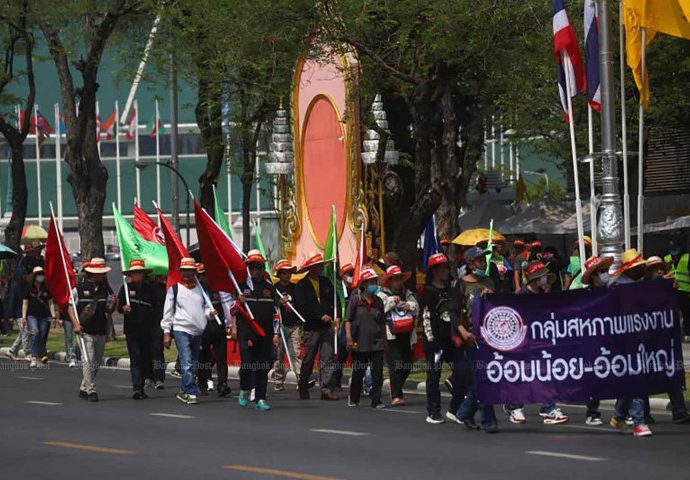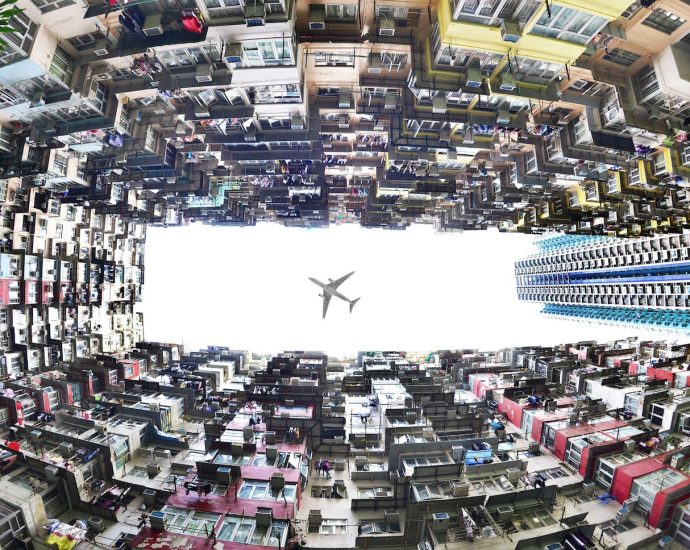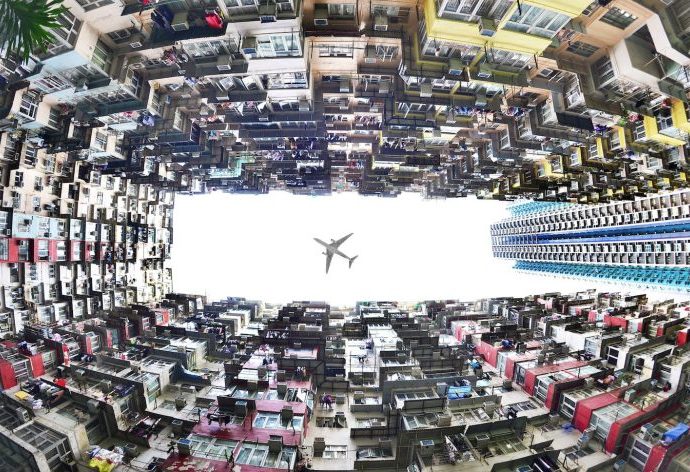China’s plastic surgery boom: ‘I’ve had 100 operations and will never stop’
BBC Eye

 BBC
BBCAbby Wu was just 14 when she had cosmetic surgery for the first time.
After receiving hormone treatment for an illness, Abby’s weight increased from 42kg (6 stone 8lbs) to 62kg (9 stone 11lbs) in two months.
The change hadn’t gone unnoticed by her drama teacher.
“My teacher said, ‘You were our star but now you’re too fat. Either give up or lose weight fast,'” recalls Abby, who was preparing for her drama exams at the time.
Abby’s mother stepped in, taking her to get liposuction to remove fat from her belly and legs.
Abby remembers her mother’s words as she waited in the clinic in a hospital gown, nervous about the impending operation.
“Just be brave and walk in. You’ll become pretty once you’re out.”
The surgery was traumatic. Abby was only given partial anaesthesia and remained conscious throughout.
“I could see how much fat was extracted from my body and how much blood I was losing,” she says.

 Family handout
Family handoutNow 35, Abby has gone on to have more than 100 procedures, costing half a million dollars.
She co-owns a beauty clinic in central Beijing and has become one of the most recognisable faces of China’s plastic surgery boom.
But the surgeries have come at a physical cost.
Sitting in front of a mirror inside her luxury duplex apartment in Beijing, she gently dabs concealer onto bruises from a recent face-slimming injection – a procedure she undergoes monthly to help her face appear “firmer and less chubby” after three jaw reduction surgeries removed too much bone.
But she insists she has no regrets about the surgeries and believes her mother made the right decision all those years ago.
“The surgery worked. I became more confident and happier, day by day. I think my mum made the right call.”

 Abby Wu
Abby WuOnce seen as taboo, plastic surgery has exploded in popularity over the last 20 years in China, fuelled by rising disposable incomes and shifts in social attitudes, in large part driven by social media.
Every year, 20 million Chinese people pay for cosmetic procedures.
Overwhelmingly, it is young women who seek surgery. Eighty per cent of patients are women and the average age of someone receiving surgery is 25.
While appearance has always been important in Chinese culture, particularly for women, beauty standards in the country are changing.
For years, the most sought-after features were a blend of Western ideals, anime fantasy and K-Pop inspiration: The double eyelid, the sculpted jawline, the prominent nose, and the symmetrical face.
But lately, more disturbing procedures are on the rise – chasing an unrealistic, hyper-feminine, almost infantile ideal.
Botox is now injected behind the ears to tilt them forward, creating the illusion of a smaller, daintier face.
Lower eyelid surgery, inspired by the glassy gaze of anime heroines, widens the eyes for an innocent, childlike look.
Upper lip shortening narrows the space between lip and nose, thought to signal youth.
But much of this beauty is built for the screen. Under filters and ring lights, the results can look flawless. In real life, the effect is often uncanny – a face not quite human, not quite child.

 TikTok
TikTok
 SoYoung
SoYoungCosmetic surgery apps like SoYoung (New Oxygen) and GengMei (More Beautiful) – claiming to offer algorithm-driven analysis of “facial imperfections” – have been surging in popularity.
After scanning and assessing users’ faces, they provide surgery recommendations from nearby clinics, taking a commission from each operation.
These and other beauty trends are shared and promoted by celebrities and influencers on social media, rapidly changing what’s considered desirable and normal.
As one of China’s earliest cosmetic surgery influencers, Abby has documented her procedures across major social media platforms and joined SoYoung soon after it launched.
Yet despite having undergone more than 100 procedures, when she scans her face using SoYoung’s “magic mirror” feature, the app still points out “imperfections” and suggests a long list of recommended surgeries.
“It says I have eye bags. Get a chin augmentation? I’ve done that.”
Abby seems amused.
“Nose-slimming? Should I get another nose surgery?”
Unlike typical e-commerce sites, beauty apps like SoYoung also offer a social media function. Users share detailed before-and-after diaries and often ask superusers like Abby for their advice.
‘My skin felt like there was cement underneath’
To meet surging demand, clinics are opening up rapidly across China.
But there’s a shortage of qualified practitioners and large numbers of clinics are operating without a licence.
According to a report by iResearch, a marketing research firm, as of 2019, 80,000 venues in China were providing cosmetic procedures without a licence and 100,000 cosmetic practitioners were working without the right qualifications.
As a result, it’s estimated that hundreds of accidents are happening every day inside Chinese cosmetic surgery clinics.
Dr Yang Lu, a plastic surgeon and owner of a licensed cosmetic surgery clinic in Shanghai, says in recent years the number of people coming for surgeries to repair botched operations has been growing.
“I’ve seen many patients whose first surgery was botched because they went to unlicensed places,” Dr Yang says.
“Some even had surgery inside people’s homes.”


Yue Yue, 28, is among those to have surgery that went badly wrong.
In 2020 she received baby face collagen injections – designed to make the face appear more plump – from an unlicensed clinic opened by a close friend. But the fillers hardened.
“My skin felt like there was cement underneath,” she says.
Desperate to undo the damage, Yue Yue turned to clinics she found through social media – well-known names – but the repairs only made things worse.
One clinic attempted to extract the filler using syringes. Instead of removing the hardened material, they extracted her own tissue, leaving her skin loose.
Another clinic tried lifting the skin near her ears to reach the filler underneath, leaving her with two long scars and a face that looked unnaturally tight.
“My entire image collapsed. I lost my shine and it’s affected my work [in human resources for a foreign company in Shanghai] too.”
She found Dr Yang through SoYoung last year and has since undergone three repair surgeries, including for her eyelids which were damaged during a previous operation by another clinic.
But while Dr Yang’s surgeries have brought visible improvements, some of the damage from the botched procedures may be permanent.
“I don’t want to become prettier any more,” she says.
“If I could go back to how I looked before surgery, I’d be quite happy.”
‘It ruined my career’
Every year, tens of thousands like Yue Yue fall victim to unlicensed cosmetic clinics in China.
But even some licensed clinics and qualified surgeons aren’t following the rules strictly.
In 2020, actress Gao Liu’s botched nose operation – in which the tip of her nose turned black and died – went viral.
“My face was disfigured and I was very down. It ruined my acting career.”
She had received the nose surgery at a licensed Guangzhou clinic called She’s Time’s from Dr He Ming, who was described as its “chief surgeon” and a nose surgery expert.
But in reality Dr He was not fully qualified to perform the surgery without supervision and had not obtained his licensed plastic surgeon status from the Guangdong Provincial Health Commission.
Authorities fined the clinic, which closed soon after the scandal, and barred Dr He from practising for six months.
However, weeks before She’s Time’s was officially dissolved, a new clinic, Qingya, requested to register at the same address.

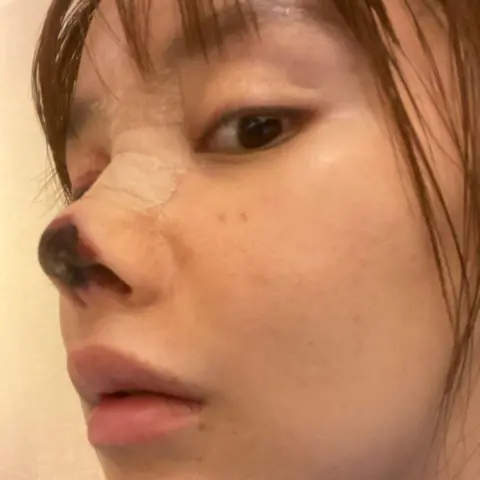 Gao Liu
Gao LiuBBC Eye has found strong links between She’s Time’s and Qingya, such as the same Weibo account and the retention of several staff, including Dr He.
The BBC has also learned that Dr He only obtained the licensed plastic surgeon qualification in April 2024, even though he was technically barred from applying for the status for five years from the date he was sanctioned in 2021.
Qingya now claims to have opened 30 branches.
Dr He, Qingya and Guangdong Provincial Health Commission did not respond to the BBC’s requests for comment.
The Chinese Embassy in the UK said: “The Chinese government consistently requires enterprises to operate in strict compliance with national laws, regulations, and relevant policy provisions.”
Four years and two repair operations later, Gao Liu’s nose remains uneven.
“I really regret it. Why did I do it?”
China’s Central Health Commission has been trying to crack down on the issue of under-qualified health practitioners performing tasks beyond their expertise in recent years – including ordering local health bodies to improve regulation and issuing stricter guidelines – but problems persist.
From job offer to debt and surgery – within 24 hours
In today’s China, looking good is important for professional success.
A quick search on popular job recruitment platforms reveals many examples of employers listing physical requirements for roles, even when they have little to do with the actual work.
One receptionist role asks for candidates to be “at least 160cm tall and aesthetically pleasing”, while an administrative job demands “an appealing look and an elegant presence”.
And now that pressure is being exploited by a growing scam in some Chinese clinics in which vulnerable young women are offered jobs, but only if they pay for expensive surgeries carried out by their would-be employers.
Da Lan, not her real name, applied for a “beauty consultant” job at a clinic in Chengdu, south-western China, on a popular recruitment website in March 2024.
After the interview, she was offered the position that same evening.
But she says when she began her role the next morning, she was taken to a small room by her manager, who scanned her up and down and gave her an ultimatum – get cosmetic work done or lose out on the job.
Da Lan says she was given less than an hour to decide.
Under pressure, she agreed to undergo double eyelid surgery – priced at over 13,000 yuan (£1,330) – more than three times the monthly salary of the role – with more than 30% annual interest.
She says staff took her phone and used it to apply for a so-called “beauty loan,” falsifying her income details. Within a minute, the loan was approved.
By noon, she was undergoing medical tests. An hour later, she was on the operating table.
From job offer to debt and surgery – all within 24 hours.
The surgery did nothing for her job prospects. Da Lan says her manager belittled her, shouting her name in public and swearing at her.
She quit after just a few weeks. Looking back, she believes the job was never real.
“They wanted me to leave from the beginning,” she says.
Despite having worked there for more than 10 days, she was paid only 303 yuan ($42). With help from her friends, Da Lan paid off the debt for her surgery after six months.
BBC Eye spoke to dozens of victims, and met three including Da Lan in Chengdu, a city that has set out to become China’s “capital of cosmetic surgery”. Some have been trapped in much larger debt for years.
The clinic Da Lan says scammed her had previously been reported by other graduates and exposed by local media, but it remains open and is still recruiting for the same role.
This scam isn’t limited to clinic jobs – it’s creeping into other industries.
Some live-streaming companies pressure young women to take out loans for surgery, promising a shot at influencer fame.
But behind the scenes, these firms often have undisclosed agreements with clinics – taking a cut from every applicant they send to the operating table.


In a bohemian-style café in Beijing, the perfect setting for a selfie, Abby meets her friends for coffee.
The trio adjust their poses and edit their faces in great detail – extending eyelashes and reshaping their cheekbones.
When asked what they like most about their facial features, they hesitate, struggling to name a single part they wouldn’t consider altering.
The conversation turns to chin implants, upper-lip shortening, and nose surgery.
Abby says she’s thinking about another nose job – her current one is six years old – but surgeons are finding it difficult to operate.
“My skin isn’t as stretchable after so many procedures. The doctors don’t have much to work with. You can’t give them enough fabric for a vest and expect a wedding dress.”
The metaphor lingers in the air, underscoring the toll taken by all of the operations.
But despite everything, Abby has no plans to stop.
“I don’t think I’ll ever stop my journey of becoming more beautiful.”
Odd Indian laws: Why not walking your dog could land you in jail

 AFP
AFPIn India, you can face criminal charges for tethering an animal on the street, flying a kite in a manner that causes alarm, skipping a school attendance order or handing a feeding bottle to a mother who can’t breastfeed.
Of the 882 federal laws on the books, 370 contain criminal provisions – together criminalising 7,305 acts and omissions. These range from the absurd to the serious: failing to give a month’s notice before quitting your job or not walking your dog enough, to offences like illegal arms possession, murder and sexual assault.
Delhi-based think-tank Vidhi Centre for Legal Policy calls it “India’s crisis of over-criminalisation”.
In a new report, The State of the System: Understanding the Scale of Crime and Punishment in India, the think-tank has produced the country’s first comprehensive database of crimes, mapping the extent of criminalisation across 370 federal laws.
The report flags India’s habit of reaching for criminal law to solve just about everything – even the mundane. It notes that many laws criminalise “routine, everyday actions”.
You could, for instance, be charged for tethering your goat on a public street, fixing a leaky tap without a licence or not naming the owner of a building when asked.
Then there are the truly obscure offences – like a parent ignoring a school attendance order, applying for a driver’s licence when banned or littering in a zoo. Basically, there’s a criminal penalty waiting around every corner of daily life.

 Getty Images
Getty ImagesLet your pigs wander on to a field or road and you could be fined 10 rupees (12 cents). Disturb an animal or litter in a zoo? Six months in jail or a 2,000-rupee fine. And failing to exercise your dog can cost you up to 100 rupees and three months in jail.
Promoting infant milk substitutes or feeding bottles to pregnant women or mothers can lead to up to three years in jail or a 5,000-rupee fine. (This was meant to curb aggressive marketing by formula food companies, but the law also applies to individuals, which makes it controversial.)
Jail is the go-to punishment in India – 73% of crimes carry prison terms ranging from a single day to 20 years.
More than 250 offences across 117 laws penalise delays in filing documents – everything from wealth and property tax returns to gift declarations, the report finds.
Some 124 crimes across 80 laws criminalise obstructing a public officer, often without clearly defining what causes “obstruction”.
Even the death penalty isn’t off the table – not just for murder or mutiny, but for damaging an oil or gas pipeline or a sentry caught sleeping on duty. In all, a staggering 301 offences in India can legally cost you your life.
Out of 7,305 offences under central laws, nearly 80% come with fines – from as low as two rupees to a staggering 50m rupees.
To be fair, many of these provisions are rarely used – India’s crime records bureau tracks around 50 laws, even though 370 carry criminal penalties.
“They’re not heavily enforced, but they create ample opportunities for rent-seeking,” Naveed Mehmood Ahmad, co-author of the study at Vidhi Centre for Legal Policy, told me.
“There’s enough in the books to jail almost anyone for some technical non-compliance. It’s less about actual use and more about the potential for misuse.”

 AFP
AFPThis “excessive use of criminal law not only disrupts the daily lives of ordinary citizens but also creates significant barriers for business operations”, the report says.
Businesses in India face a maze of regulations, but using criminal law as the default for non-compliance is excessive, disproportionate and often counter-productive, experts say.
The report also talks about some glaring inconsistencies in crime and punishment.
Rioting – the use of force or violence by an unlawful assembly – is punishable with up to two years of imprisonment. Meanwhile, falsely reporting a birth or death for official records can lead to three years of imprisonment.
The irony? Violence in public gets a lighter sentence than a lie on paper.
Even more striking: crimes of vastly different severity carry the same penalty – like practicing homoeopathy without a licence, jumping a red light, or forcing someone into labour – all punishable with a one-year sentence.
The sheer number of crimes tied to everyday life and business shows how heavily the state leans on criminalisation to enforce compliance, the report says.
“This over-reliance has significant costs, not just for citizens and businesses, but also for state machinery.”
Over 34 million criminal cases are pending in India’s courts, with 72% stuck for more than a year. Prisons are overcrowded, running at 131% capacity, while courts and police forces continue to grapple with chronic staff shortages

 Getty Images
Getty ImagesEven the law-and-order machinery is stretched. As of 1 January 2023, India had just 154 police personnel per 100,000 people – well below the sanctioned 195. Nationwide, there are 581,000 vacancies against an approved strength of 2.72 million.
“Even then, we continue to rely on this overburdened system to combat minor infractions, including those that attract nominal fines,” the report says.
It says that criminal law should be limited to acts that threaten core societal values – like public safety, national security, life, liberty, property and social harmony.
Authorities say they plan to scrap criminal penalties in more than 100 legal provisions – on top of the 180 already axed in 2023. It’s not just legal clean-up; it’s a chance to rethink how the law treats people. Less fear, more trust. Less suspect, more citizen.
Paetongtarn dismisses cabinet reshuffle rumours

Prime Minister Paetongtarn Shinawatra on Tuesday dismissed speculation about a cabinet reshuffle, insisting that the state is still united and everything will be constant.
Addressing concerns about a probable shake-up amid speculations about partnership conflicts and calling for modifications to some financial assets, the prime minister said she has no plans for a shake-up.
” Anything remains the same, and I’m aware of opinion polls and open to all perspectives. Moreover, everything is transitory, even the placement of the prime minister. We all may be quiet,” she said.
Ms Paetongtarn was also firm when asked about the possibility of coalition partner Bhumjaithai being axed and replaced by the Palang Pracharath Party ( PPRP ).
She insisted that there would be no change at this stage, also if a Nida Poll public judgment study showed that many people expected the business secretary and the crops and cooperatives secretary to be replaced.
The head of the ruling party acknowledged that Pheu Thai formed a partnership with pro-military events despite its vow not to join hands with them.
She said Pheu Thai did not get the bulk needed and noted that the problem was fairly later coming, considering their association was formed about two years ago.
The prime minister said that she was satisfied with alliance unity and that every partnership companion had done its best to adopt state laws and provide benefits, despite some hurdles.
She also said that although she and her father, former prime minister Thaksin Shinawatra, have differing opinions over some issues, they would never be in conflict.
Deputy Prime Minister and Defence Minister Phumtham Wechayachai said on Tuesday there has been no signal about a cabinet reshuffle from the prime minister, and all the talk about it seems to come from outsiders.
He admitted that Pheu Thai and Bhumjaithai have differing views, but said they are not in conflict and can be ironed out. When asked if the alliance would remain intact, he said that as long as each party stays committed to the principles they agreed upon when forming the coalition, the government will continue.
Klatham Party leader Narumon Pinyosinwat, who currently serves as agriculture and cooperatives minister, echoed Mr Phumtham’s remarks that talk about a reshuffle came from the media or analysts, not the prime minister.
She said the party is happy with its cabinet share, and in case of a reshuffle, the party’s quota will not be affected. She also strongly denied reports that Klatham is lobbying for the interior minister post currently held by the Bhumjaithai Party.
PPRP secretary-general Paiboon Nititawan on Tuesday rejected the rumour about rejoining the coalition government.
Commentary: With Southeast Asia hard hit by Trump tariffs, here’s what ASEAN can do next
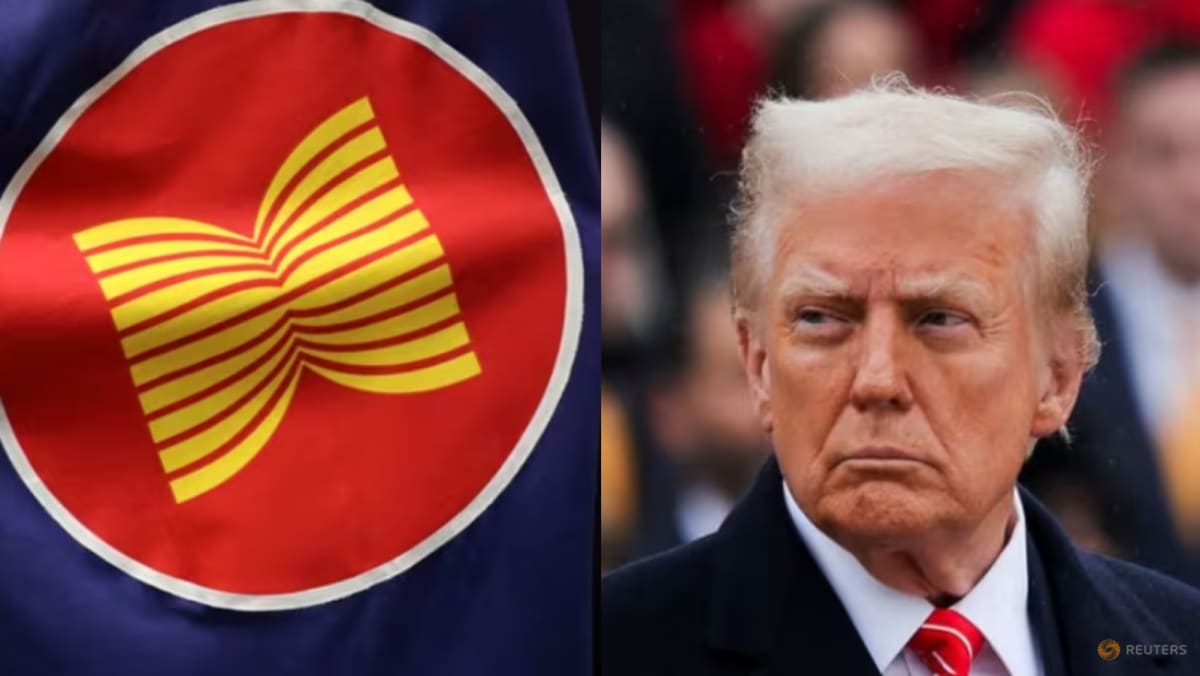
WHAT ASEAN DOES NEXT
The next phase of ASEAN’s reaction will need to consider these international interests. It can help to complete a command vacuum in internationalism. There are two concepts that ASEAN now practises that can guide behavior and assistance.
Second, if ASEAN does what’s in its objectives consistent with its principles, that may contribute to global efforts to protect the rules-based international trading system.
That includes avoiding retribution that would just take more economic problems, using actions consistent with laws and organizations ASEAN has committed to, and continuing to work as a group. Deviating from those guiding rules perhaps understand ASEAN.
Second is to guard and practise ASEAN importance. ASEAN is not only key to its East Eastern member states, it is key to broader Eastern cooperation. ASEAN should use its importance, or chance losing it.
ASEAN may find willing companions in its own place. The foreign ministers of China, Japan and South Korea met a few days before the news of Mr Trump’s taxes, agreeing to simultaneously listen to US taxes and “to improve the deployment of RCEP”, referring to the Regional Comprehensive Economic Partnership, the 15-country free trade agreement that was created and is led by ASEAN.
Commentary: High-profile pneumonia deaths highlight the threat of respiratory infections

Lung infections are a frequent and evolving wellness threat. Continued monitoring and protecting actions are needed – especially for those at high risk.
WHY PNEUMONIA Bones A MAJOR Heath Risk
Pneumonia is a lung infection that can be caused by bacteria, viruses or mushrooms. Among the pathogens most closely monitored for their public health impact are respiratory syncytial virus ( RSV), influenza viruses, pneumococcal bacteria and SARS-CoV-2.
Pneumonia does not distinguish. Infants and young children are at heightened risk because their immune systems are also developing. Older people are also very susceptible to severe problems, given the natural decrease in immune function with time.
Those with serious problems such as diabetes, asthma or heart disease face more threats, since do immunocompromised people, including those undergoing chemotherapy or living with HIV or AIDS.
A new study published in The Lancet found that compared to influenza, RSV infection in people resulted in higher chances of mortality, more intensive care unit admissions and greater care usage.
It furthermore found RSV people had higher ICU admission prices than COVID-19 clients with updated vaccinations.
Influenza, generally assumed to be a youth disease, is a major threat to elders and those with actual health conditions. The research showed that older people and patients with diabetes had higher chances of deaths when hospitalised for RSV.
While virus and COVID-19 have been at the forefront of public health initiatives, RSV has been slowly exacting a burden on healthcare systems, making it important for both healthcare companies and the public to appreciate its risks.
US tariff saga puts wage hike on ice

The government’s commitment to raise the minimum wage to 400 baht hit a barrier on Tuesday after the tripartite table delayed its decision amid businesses ‘ concerns over an economic consequences following the recent US tax adjustments.
Tuesday’s 15-member board meeting, chaired by the Labour Ministry’s continuous minister, Boonsong Thapchaiyuth, was unable to verify that the climb promised before Labour Day on May 1 by Labour Minister Phiphat Ratchakitprakarn may be implemented.
Companies ‘ members who attended the meeting said several particulars were lacking, said Mr Boonsong. The second appointment has now been postponed to an undefined meeting in May, he said.
Staff members also agreed that this is not the proper time for a pay climb due to the US taxes. But, Mr Boonsong said that business that could provide the income excursions, like hospitality or services, would not be affected by the US price plan.
Asked whether next year’s income trek for the companies and tourism industries played a component in the selection, Mr Boonsong said elements such as the number of tourists to Thailand had been considered.
Meanwhile, employers have complained about a lack of relief measures from the government since the initial hike took effect in January.
Natthakit Khettrakarn, representing the group at the meeting, said employers have been forced to shoulder” a heavy burden”. He also touched on the 36 % US levy on Thai imports into the US, and agreed the wage hike could wait for now.
Mr Phiphat earlier said the details of the hike would be agreed at the April 8 meeting. However, only eight members of the tripartite wage committee attended, resulting in the postponement to April 22.
Mr Phiphat voiced concern that the wage hike, if applied in all professions and sectors nationwide, would affect some 500,000 small and medium businesses.
Chinese humanoid robots get reality check in half-marathon debut – Asia Times
Six out of 21 Chinese computers completed the world’s primary half marathon ( 21. 1 miles ) for human drones in Beijing on April 19, with the success setting a record period of 2 days and 40 days.
Over 12,000 individuals participated in the workout on the same day, and the individual success reached the terminal in 1 hours and 2 moments.
The Tien Kung Ultra robot , developed by X-Humanoid, a Beijing-based state-owned organization, won the race for human computers. It is 1. 8 feet tall and weighs 52 pounds.
The first runner-up, Noetix Robotics ’ N2, finished the half-marathon in 3 hours 37 minutes. It is 1. 2 feet tall, weighs 29 pounds, and wears children’s coaches.

[embedded information]
The next runner-up, DroidUp’s X02, finished the competition in 4 hours and 50 minutes. It wears boxing boots.
An illegal group entered the competition using a Unitree G2 machine, but the machine fell at the starting place and became a talking point of the celebration.
Unitree said that the company did not send a group to join in this workout as it has been busy lately. It added that anyone who bought a Unitree machine can install it in pursuits, but distinct training may lead to different results.
On April 10, Unitree released images saying it will be live-streaming machine conflict in about a fortnight.

[embedded information]
Tang Jian, chief technology officer of X-Humanoid, said his staff only used one machine to finish the half-marathon, while another people needed to change computers many times.
He admitted that the X-Humanoid machine had fallen once during the triathlon according to power failure and had three power derivatives during the competition.
“We have spent seven to eight times preparing for this workout by doing a lot of tests on the machine and fine-tuning its engine, ” Tang said.
“Firstly, we reduced our robot’s fat; firstly, we improved its heat absorption system to prevent burning; Finally, we added a insulation function to reduce wear on its single and joint components, ” he added. “ What is more important is that we increased the length of our robot’s arms to work faster. ”
“The industrialization of human robots will include three phases. In the first stage, robots will be used in standard industries; therefore, they will be used in certain business environments to complete tasks such as presentation and scanning codes; eventually, they will be deployed to properties to play the role of maid and maid, ” Tang said.
He said it would get Taiwanese companies three to five years to market their drones, by which time they may be deployed in homes to provide people and perform chores.
X-Humanoid, formally known as Beijing Humanoid Robot Innovation Center, was formed simultaneously by technology firm Ubtech, gadgets and electric car maker Xiaomi and the Beijing municipal state.
Stocks of the Hong Kong-listed Ubtech Robotics increased 2. 9 % on Tuesday. Stocks of the state-owned Shoucheng Holdings, which has invested in X-Humanoid and Noetix, rose 4 %.
Testing ‘cerebellums’
According to the workout rules, each team is build three staff members to help a machine. The machine does not need an pilot system; its distant joystick can be wired or wireless.
The contest landscape includes level land and stairs, with a maximum hill of 9 degrees. The competition way has six left-turn and eight right-turn roads.
One of the robot developers who joined the marathon said this activity aims to test robots ’ cerebellums ( ability to control the body ) instead of their cerebrums ( ability to make decisions and think ).
Of the 21 machine athletes, just six completed the competition, while the remaining 15 failed.

A little machine developed by Beijing Polytechnic University kids overheated and went up in smoke. Some other groups sprayed ocean on their computers to keep them cool.
A female-looking machine walked a little range and fell. One Gundam ( from a Japanese comic ) robot used four fans to move forward, but crashed seconds after beginning its journey.
“The winning technique of Noetix’s N2 robot is its steady mechanical construction and superior engine performance, ” Hu Chenxu, chairman and chief professor of Noetix, told the media. “Small computers have a lot of advantages, such as higher flexibility and agility. Some research institutes use small drones to complete their studies work. ”

“Robots need a high resilience to go from the laboratory to the marathon record, ” he said.
He said he after worried that the N2 machine, which is more like a dancer, would not be a great skater; happily, the machine performed exceedingly well, except it needed a new distant controller after a power change.
He said Noetix’s robots are now used in medical research, education, exhibitions, social, and hospitality sectors and will be deployed for scenarios such as elderly care, professional inspection and industrial security.
In September 2023, Jiang Zheyuan, a PhD student at Tsinghua University, then 25, founded Noetix Robotics. So far, the company has raised five rounds of funding. It planned to deliver one thousand robots this year and expected positive cash flow in the fourth quarter.
Jiang told Sohu. com in an interview in March that his company needed to commercialize its products as early as possible due to its limited financial resources, unlike DeepSeek, an artificial intelligence company with sufficient resources to pursue technical ideals.
Regarding the robotic race between China and the United States, Jiang said China has a substantial cost advantage. He said it costs only 40 yuan ( US$ 5. 5 ) per hour to collect robotic data in China but US$ 48 per hour in the US. Besides, he said a wide range of industries in China can provide different environments for companies to improve the algorithms of their robots.
He said that using Chinese humanoid robots will continue to focus on education and exhibition in the next three years. He said Noetix plans to launch a small robot that costs below 10,000 yuan next year.
According to the Gaogong Robot Industry Research Institute, total sales of humanoid robots will reach 12,400 units or 6. 34 billion yuan globally in 2025. Chinese companies may sell about 7,300 humanoid robots during this period.
Read: Unitree’s humanoid robot a great side-flip forward for China
Between giants: South Korean moment for a balanced foreign policy – Asia Times
South Korea is heading into a critical round of trade deals with the United States in Washington on April 24. These discussions come at a time of mounting pressure from both Washington and Beijing, and the choices Korea makes today will considerably form its future economic and strategic direction.
The United States is urging South Korea to fit more tightly with its broader attempts to counter China. Washington is seeking assistance on a number of sides – export controls, purchase restrictions and supply chain reform – all aimed at curbing Beijing’s industrial and economic impact. But this is no longer simply about business. It is a turning point for Seoul, a minute to decide whether to pursue the US guide, assert its autonomy or get a more measured path – a multi-alignment strategy.
What the US needs
At the heart of US expectations is the issue of taxes. The Trump presidency has imposed 25 % mutual tariffs on major Asian imports, especially cars and material. Though the taxes were suspended for 90 days, Korea is pressing for continuous treatment to reduce financial uncertainty for its companies.
The disparity in diplomatic trade is another key issue. The US trade deficit with Korea reached$ 55. 7 billion in 2024, prompting Washington to call for greater exports of British goods, especially energy materials like liquefied natural gas. In reply, Korea is proposing broader cooperation in proper sectors, such as manufacturing and involvement in major US facilities projects, including the Alaska gas pipeline – offering common economic and geopolitical benefits.
Semiconductors are a major point of contention. With the US reportedly considering new tariffs on Korean chips, Seoul has already unveiled a 33 trillion won ($ 23 billion ) support package to reinforce its semiconductor industry. This reflects Korea’s desire to remain a global tech leader while bracing for possible shocks from US trade policy.
Although not officially on the agenda, the sensitive issue of defense cost-sharing may also surface in the talks. While South Korean officials insist this is unrelated to trade, there is speculation that Washington may raise it, potentially complicating the tone of the negotiations.
Perhaps the most complex issue is Korea’s economic relationship with China. The US is expected to pressure Seoul to reduce its dependency on Chinese trade and align with Washington ’s export controls that target exports of advanced technology to Beijing.
While South Korea has shown some willingness to cooperate, it is also seeking economic incentives to soften the blow of potential losses from a slowdown in China-bound trade. Washington ’s push for Korea to join the “Economic Prosperity Network ” – a framework aimed at restructuring global supply chains away from China – is further complicating matters. South Korean industries, still wary after the THAAD backlash, are concerned about provoking China and facing another wave of economic retaliation.
Meanwhile, the US has implemented new outbound investment restrictions on certain Chinese tech sectors, effective January 2025. While these measures primarily affect American companies, Seoul is monitoring them closely, assessing possible indirect impacts and preparing suitable responses.
Seoul is also seeking a reduction or delay of new tariffs on South Korean exports and, in return, offering deeper cooperation in fields like shipbuilding, clean energy, and digital infrastructure – areas where mutual benefit can be found without fully compromising strategic autonomy.
The high cost of saying ‘yes ’ or ‘no’ to Washington
The stakes are high. If Korea says “yes ” to US demands, the benefits are tangible. Tariff relief would directly support key Korean industries, and expanded cooperation in semiconductors, batteries, and renewable energy could enhance Korea’s technological edge. Such alignment would deepen the bilateral alliance and strengthen Seoul’s presence in Washington-led initiatives.
Yet the risks are equally significant. Aligning too closely with Washington could provoke harsh retaliation from China – Korea’s largest trading partner. Beijing has already warned countries seeking exemptions from the Trump-era tariffs not to make deals at its expense. While China claims to respect nations ’ efforts to resolve trade disputes with the US, it insists that they must also “stand on the side of fairness and justice ” and “on the correct side of history. ”
The tone of China ’s recent statements suggests that it is taking this issue very seriously and is in no mood to let such deals proceed without imposing serious consequences on countries that act against its interests.
As seen during the THAAD deployment, Beijing may react with export bans, consumer boycotts, or diplomatic pressure. Overreliance on the US could also expose South Korea to political shifts in Washington and limit Seoul’s freedom to maneuver. Most importantly, South Korea risks losing its strategic autonomy – the ability to set its own course and engage multiple powers on its own terms.
On the other hand, if South Korea refuses US demands, it preserves its strong economic relationship with China. It avoids immediate retaliation, protects its exports and upholds its position as an independent middle power.
But this approach is also not without cost. US incentives for Korean firms could disappear. Access to American subsidies and collaborative opportunities in high-tech sectors might dry up. Korea could be excluded from future US-led initiatives such as the Indo-Pacific Economic Framework, QUAD or emerging digital and defense networks. Washington might also begin to question Korea’s reliability as an ally, weakening Seoul’s leverage in future security negotiations.
Why Korea needs a multi-alignment strategy
Amid this dilemma, a multi-alignment strategy emerges as the only sustainable solution.
With President Yoon Suk-yeol now removed and the domestic political climate rapidly changing, South Korea is entering a new phase. Lee Jae-myung of the Democratic Party, currently the frontrunner for the presidency, is unlikely to accept all of Washington ’s demands without recalibration. If pushed too far, relations between the two allies could face serious strain. In this evolving environment, a middle path – firm yet flexible – may be Korea’s best option.
Korea does not need to pick a side between the United States and China. It needs a smarter, more dynamic approach – one that prioritizes South Korean interests, mitigates risks, and enhances global credibility.
Multi-alignment offers precisely this. It allows Korea to cooperate with Washington in strategic areas like semiconductors, clean energy, and defense technologies – sectors where South Korea can gain from joint investment, research, and global market access. Simultaneously, it lets South Korea sustain strong trade and investment ties with China, avoiding unnecessary economic damage and ensuring the health of key industries.
A multi-alignment approach also opens the door to diversified diplomacy. South Korea can deepen its engagement with India, ASEAN, and the European Union while enhancing trilateral cooperation with China and Japan on vital areas such as climate change, logistics, and public health. Broadening partnerships with BRICS and Eurasian countries can further reduce dependence on any single power and unlock new economic opportunities.
Internally, South Korea must reinforce this strategy by investing in its domestic strengths – innovation, energy independence, and technological resilience. Building homegrown capabilities will give South Korea the freedom to navigate great-power rivalries without being constrained by external dependencies.
The era of uncritical alignment with Washington is over. Multi-alignment gives Korea multiple options – flexibility without fragmentation. It empowers Seoul to operate confidently in a fragmented world, defending its national interests while remaining an active and respected global player.
At this moment of crossroads, South Korea must choose wisely. Siding fully with one power risks long-term subordination. Refusing both invites isolation. The real answer lies in balance – a multi-alignment strategy that keeps Korea strong, sovereign, respected and prosperous.
This is not a moment to choose sides – it is a moment to shape outcomes. South Korea must rise to its full potential as a true pivotal state – not as a passive bystander in great-power rivalry, but as a confident architect of a new regional balance of power and a bridge-builder in an increasingly polarized world.
Politically connected firms benefit from Trump tariff exemptions – Asia Times
This content was originally published by ProPublica, a Pulitzer Prize-winning exploratory office.
After President Donald Trump announced sweeping new levies earlier this month, the White House released a list of more than a thousand items that would be exempted.
One product that made the list is polypropylene terephthalate, more commonly known as PET epoxy, the plastic used to produce plastic containers.
Why it was spared is questionable, and also persons in the industry are confused about the reason for the break.
But its inclusion is a win for Reyes Holdings, a Coca-Cola bottler that ranks among the largest privately held organizations in the US and is owned by a pair of sons who have donated millions of dollars to Democratic factors. Records show the business just hired a lobbying organization with close relationships to the Trump White House to make its situation on taxes.
Whether the business ’s lobbying played any role in the deduction is unclear. Torres Holdings and its lobbying did not respond to queries from ProPublica. The White House even did not comment, but some business activists say the administration has rebuffed calls for deductions.
The resin’s unexpected addition on the list exemplifies how transparent the administration ’s method for crafting its tax legislation has been. Key participants are in the black about why certain items face charges and others don’t. Tax charges have been altered without any apparent reason for the alterations. Administration officials have given conflicting information about the taxes or declined to answer queries at all.
The lack of clarity about the procedure has created problems among business professionals that politically connected firms may be winning carve-outs behind closed doors.
“It had been corruption, but it could just as easily become incompetence, ” a lawyer who works on tax legislation said of PET resin’s addition. “To be fair, this was like a hurried chaos, I am not certain who got into the White House to talk to people about the record. ”
During the first Trump presidency, there was a proper method for seeking an exemption from taxes. Businesses submitted hundreds of thousands of uses making the case for why their products should be spared. The programs were open, so the technology of the tax crafting method could be more closely examined. For clarity allowed academics to immediately assess thousands of the applications and decide that political donors to Republicans were more likely to be granted exemptions.
In Trump’s next name, at least so far, there has not been a formal application process for tax carve-outs. Industry executives and activists are making their circumstance behind closed doors. The Wall Street Journal ’s editorial board last month called “the transparency of the process ” for getting an exemption “the Beltway Swamp’s vision. ”
In the professional order formalizing Trump’s fresh tariffs, including baseline 10 % tariffs for almost all countries, exemptions were loosely defined as items in the medical, semiconductor, lumber, copper, essential vitamins and energy fields. An accompanying list detailed the specific products that would be spared.
But a ProPublica review of that list found many items that don’t fit neatly, or at all, in those broad categories– and some items that fall squarely within the categories were not spared.
The White House exclusions list, for example, included most types of asbestos, which is not generally considered a critical mineral and does n’t seem to fit in any of the exempted categories. The cancer-causing mineral, which is not generally considered critical to national security or the US economy, is still used to make chlorine, but the Biden administration ’s Environmental Protection Agency banned imports of the material last year. The Trump administration has signaled it may roll back some of those Biden-era restrictions.
A spokesperson for the American Chemistry Council, which had pushed back on the ban because it could hurt the chlorine industry, said the trade group played no role in lobbying for asbestos to get a tariff exemption and did n’t know why it was included. ( Two major chlorine companies also showed no indication of lobbying on the tariffs in their disclosure forms. )
Other items that landed on the list, despite not falling into exempted categories, are far more innocuous. Among them: coral, shells and cuttlebone, a part of the cuttlefish that is used as a dietary supplement for pets.
PET resin also does n’t fit neatly in any of the exempted categories. It’s possible the administration counted it as an energy product, experts said, because its ingredients are derived from petroleum. But other products that would have met that same low bar were not included.
“We are as surprised as anybody, ” said Ralph Vasami, executive director of the PET Resin Association, a trade group for the industry. The resin, he said, has no application for the exempted categories, unless you count the packaging those products come in.

During the fourth quarter of last year, the same period when Trump won the election, records show Reyes Holdings, the Coca-Cola bottler, enlisted Ballard Partners to lobby on tariffs. During the first quarter of this year, when Trump was inaugurated, records show that Ballard began lobbying the Commerce Department, which shapes trade policy, on tariffs. The firm has become a destination for companies looking for an in with the Trump administration. It once lobbied for Trump’s own company, the Trump Organization, and its staff has included top officials in the administration, such as Attorney General Pam Bondi and the president ’s chief of staff, Susie Wiles. Brian Ballard, its founder and a prolific fundraiser for Trump, was named by Politico “the most powerful lobbyist in Trump’s Washington. ” He was one of two lobbyists from the firm who lobbied on tariffs for Reyes Holdings, federal disclosure records show.
The billionaire brothers behind Reyes Holdings, Chris and Jude Reyes, also have their own political ties. While they have given to some Democratic candidates, the bulk of their political donations have gone to Republican causes, campaign finance disclosures show. And after Trump’s first election win, Chris Reyes was invited to Mar-a-Lago to meet privately with Trump.
The PET resin carve-out is n’t just a break for Reyes Holdings. It’s a boon to other firms that buy the resin to manufacture bottles and the beverage companies that use them. Earlier this year, the CEO of Coca-Cola said the company would transition to using more plastic bottles in the face of new tariffs on aluminum, a plan that might have been dashed if the thermoplastics were also hit with new tariffs.
Disclosure records show the company also lobbied this year about tariffs on the Hill, but the documents don’t provide detail about which policies in particular, and the company did not respond to questions from ProPublica. ( Coca-Cola has looked to make inroads with Trump, donating about$ 250,000 for his inauguration, and the CEO presented Trump with a personalized bottle of his favorite soda, Diet Coke. )
Another industry that appears to have done relatively well lobbying for carve-outs from the recent tariffs is agriculture. The exemption list includes various pesticide and fertilizer ingredients.
The American Farm Bureau Federation, an agricultural lobby, took credit for some of those exemptions in an analysis posted on its website recently, calling exemptions for peat and potash “hard fought for by agricultural organizations such as the American Farm Bureau Federation ” and “a testament to the effectiveness of farmers’ and ranchers raising their collective voice. ”
There are a number of other imports that don’t neatly fall into any of the exempted categories but might if the categories were defined loosely.
One example is sucralose, the artificial sweetener. Its inclusion will largely help companies that use the product in food and beverages. But sucralose is also sometimes used in drugs to make them more palatable. It’s not clear if the White House gave it a pass under the pharmaceutical exemption or for some other reason.
Even for the items that were spared, the reprieve may just be temporary.
The broad categories exempted are largely industries that are being investigated by the administration for potential future tariffs under its authority to administer levies to protect national security.
Alex Mierjeski and Agnel Philip contributed research. Sign up for The Big Story newsletter to receive stories like this one in your inbox.
SDP files court application to appeal against POFMA order for statements about Istana procession
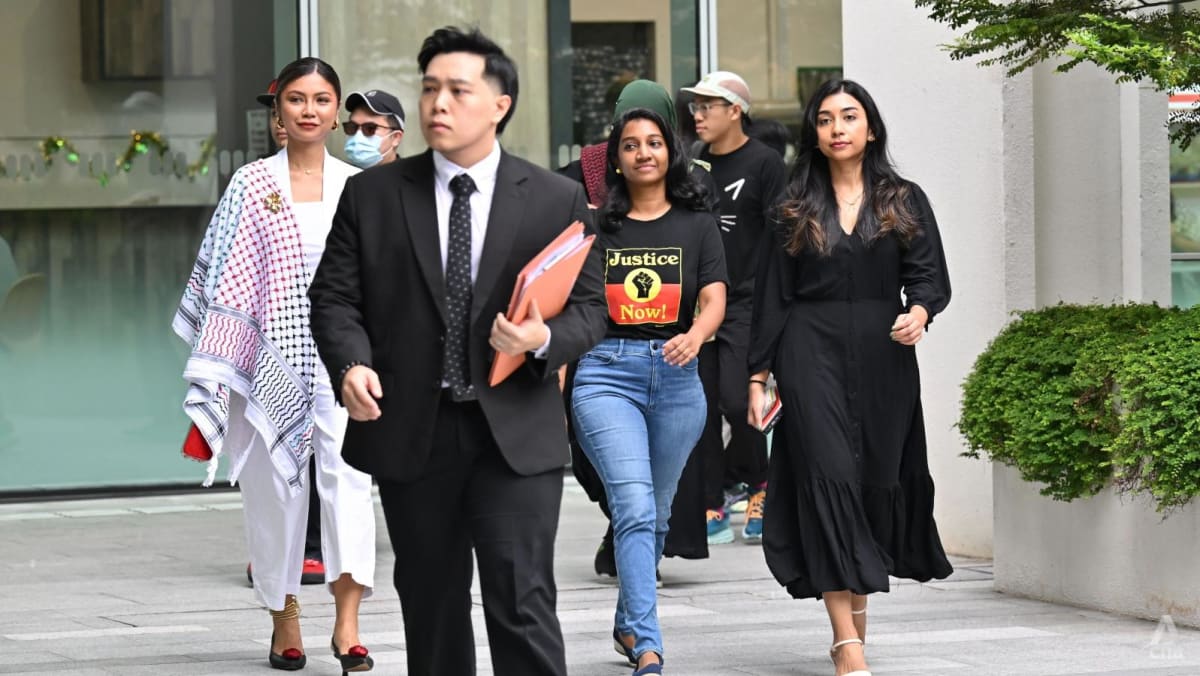
BACKGROUND
SDP’s statements were made regarding a scenario where three ladies – Annamalai Kokila Parvathi, Siti Amirah Mohamed Asrori and Mossammad Sobikun Nahar – had reportedly planned a march on Feb 2, 2024, in support of the Palestinian cause.
The people were charged on Jun 27 last year with people buy crimes.
Two days later, SDP was issued a correction attempt for Facebook, Instagram, and TikTok comments it made on Jun 27 and Jun 28 about the claims against the people.
According to federal website Objectively, the articles contained two false claims: that the three ladies were prosecuted for organising assistance for the Arab people; and that the state, and in particular a secretary, prosecuted the three ladies because they had expressed opinions that the government did not agree with.
According to the Ministry of Home Affairs, SDP complied with the adjustment attempt on Jun 29.
But, on Apr 7, the celebration submitted an application to change the adjustment order, explaining in an associated statement that this was to raise concerns “ahead of the General Election”.
This application was rejected by Mr Shanmugam after he found no merit in it.






